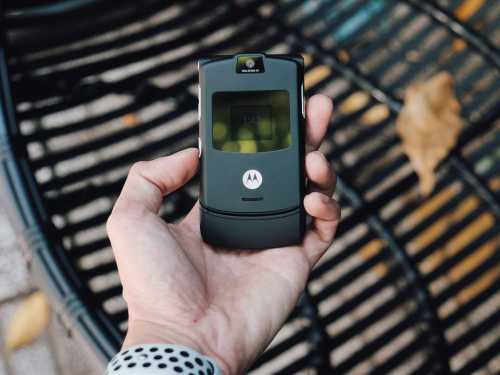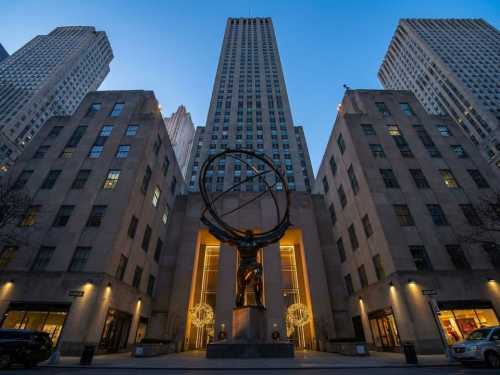
In the world of technology, it's rare to find a story of rise and fall as fascinating as that of Motorola. From the first radios to the revolutionary mobile phones, this company was not just a participant in the technological race – it was its pioneer and driving force. So what happened? First things first.
How Motorola was founded
The future founder of Motorola, Paul Galvin, was born in 1895 in Harvard. From an early age, he showed entrepreneurial abilities, selling sandwiches and ice cream at the train station, and he did it without a license, hiding from the authorities. In 1914, Galvin joined the army as an artilleryman and participated in World War I. After returning, he graduated from the Illinois Institute of Technology.
In 1920, Paul got a job at a Chicago battery factory. He didn’t like the job, and a year later, he and a school friend founded their own battery company. The company lasted only two years and was shut down by the government for non-payment of a large amount of taxes. Three years later, Galvin made a second attempt in the same direction, but this business also failed to compete in the growing electricity market.
However, the failures did not break the entrepreneur. At an auction where his company's assets were being sold, Galvin bought equipment for the production of network power supplies for $ 750. In 1928, together with his brother Joseph, who invested $ 565, he founded the company Galvin Manufacturing with an initial staff of only five people. The time for the start was not easy – the Great Depression began.
The turning point came when one of the engineers suggested that he start making car radios. At first, Galvin was skeptical about the idea, believing that the radio would interfere with the driver. But when he saw an ad for a converted car radio for $250 (almost a third of the cost of the car itself), he realized the potential market.
In 1930, the company introduced its first radio under the Motorola brand, costing only $110. The name combined the word “motor” and the then popular suffix “ola”, used for sound equipment. Despite some initial problems (one of the first receivers reportedly caught fire), the product was a success. Galvin created his own network of dealers and invested heavily in advertising.
By the late 1930s, the company had begun manufacturing police radios, and with the outbreak of World War II, it focused on military developments. In 1940, the revolutionary SCR-536 (Handie-Talkie) was introduced, the first 2.3 kg (5.0 lb) radio that could be held in one hand. This was followed by the more powerful 17.3 kg (37.6 lb) SCR-300 (Walkie-Talkie), which became the standard for military communications.
In 1947, the company was renamed Motorola, and management passed to a new generation – the founder's son, Robert Galvin. He began his career in the company at the age of 16 as a storekeeper and worked his way up to president. In the late 1940s, the company made a breakthrough in the television market, releasing the Golden View model at a revolutionary price of $ 180, while the average price of competitors was about $ 300.
At the same time, the company strengthened its position in the automotive market. After acquiring the unprofitable Detrola, which had contracts with Ford, Motorola gained the opportunity to install its radios on 50% of Ford and Chrysler cars. By the mid-1950s, a contract with American Motors was added.
In 1955, the famous Motorola logo, a stylized “M,” was created by Chicago designer Morton Goldshall. That same year, the company entered the transistor market by opening a factory in Arizona, which laid the foundation for future developments in the electronics industry.
The Age of Innovation
In the 1960s, Motorola began an active international expansion. Production went beyond the United States with the opening of a plant in Mexico. By this time, the company already operated in eight countries, including Japan, which it saw as a springboard for entering Asian markets. In 1961, a Japanese office was opened, and in 1968, Motorola Semiconductor Japan was launched to produce semiconductors and integrated circuits.
The company continued to make technological breakthroughs in various directions. In 1962, the HT-200 transistor portable radio weighing only 932 grams was released. In 1966, the world's smallest portable television receiver, the Tiny Tim TV, appeared, powered by four AA batteries. An even more significant achievement was its participation in the US space program – it was through Motorola equipment that Neil Armstrong's famous first words from the moon were transmitted: “One small step for man, one giant leap for mankind.”
1972 saw the introduction of the MODAT mobile data transmission system, which allowed for the exchange of information between a car driver and a computer. The system was widely used by police and transportation companies. At the same time, Motorola developed the first digital voice encryption technology, Digital Voice Protection (DVP), which was quickly adopted by US intelligence agencies.
In 1973, Motorola released the first cell phone. The most important step was the entry into the processor market. In 1974, the company introduced the Motorola 6800 with a clock speed of 2 MHz and 78 operations. In 1979, an even more successful Motorola 68000 appeared, which was used in Macintosh computers and successfully competed with Intel products. However, IBM's victory in the personal computer war, which relied on Intel processors, subsequently significantly reduced Motorola's share of this market.
The first cell phone
But let's go back to the history of Motorola's mobile telephony, which began with Martin Cooper, who joined the company in 1957. Ten years later, he created a portable radio system for the Chicago police, and in the early 1970s he headed the company's communications systems division.
Development of the first mobile phone began in November 1972. The task was difficult – it was necessary to reduce the 15-kilogram car communication system to the size of a portable device. By the spring of 1973, a prototype Motorola DynaTAC weighing 1.1 kg and about 30 cm long appeared.
On April 3, 1973, Cooper made the first ever call from a portable cellular phone on the streets of Manhattan. Symbolically, he called his main competitor, the head of Bell Labs, Joel Engel. This call was a turning point in the history of telecommunications, although it would be another ten years before a commercial version of the phone appeared.
After investing about $100 million in development, the first commercial mobile phone appeared in 1983 – the Motorola DynaTAC 8000X. The device, 33 centimeters high and weighing about 900 grams, was equipped with a retractable antenna and a monochrome display. The battery provided 30 minutes of talk time after 10 hours of charging. The memory allowed you to store up to 30 phone numbers. At a price of about $4,000, the phone became a symbol of status and luxury.
In the late 1980s, Motorola decided to reduce its consumer brand portfolio and focus on wireless communications and computers. As a result, the business was restructured. The Quasar television division was sold and Four-Phase Systems, a computer and terminal manufacturer, was acquired for $253 million. Although the acquisition later resulted in a loss of about $200 million, it reflected the company's desire to diversify its business.
In 1989, the company introduced the MicroTAC 9800X, the first compact cell phone with a display to display the number. The $3,500 device was revolutionary—it was the first “clamshell,” although technically it only had a flip microphone. The phone fit easily in a pocket, which was an incredible achievement for the time.
The Golden Age and the First Problems
Motorola reached the peak of its power in the early 1990s. The company controlled more than half of the global mobile phone market and dominated the pager market. By this time, the company was already led by the third member of the Galvin dynasty, Christopher, who succeeded George Fisher and Gary Tooker.
The main achievement of this period was the release of the revolutionary StarTAC in 1996 – the first true clamshell in the history of mobile phones. This phone set new standards in design and functionality, strengthening Motorola's leadership in the market.
However, at the same time, the first signs of future problems began to appear. Nokia was rapidly gaining momentum, offering increasingly advanced digital phones. The Finnish company understood before others that mobile phones were becoming an important part of everyday life and should offer a variety of functions besides calls. Another serious competitor also appeared – Samsung, which was actively developing in the Asian market.
In addition, Palm entered the market with its handheld computers (PDAs), creating a new category of mobile devices. But Motorola's management, intoxicated by success, was in no hurry to release digital phones. Instead of developing promising areas of mobile communications, the company made a risky bet on the Iridium satellite communications project. Motorola had enough money for any undertaking, but these resources were directed in the wrong direction. The company continued to rely on proven technologies and was in no hurry with innovations, which gradually led to a technological lag behind competitors.
Iridium Project
In the late 1980s, Motorola conceived an ambitious satellite communications project, Iridium, that would provide global coverage and generate steady revenue from subscription fees. The project involved placing a group of 77 satellites in low Earth orbit, which would provide minimal signal delays and allow the use of compact phones.
In 1991, the project officially launched. Motorola founded a separate company, Iridium LLC, investing $400 million in exchange for a 25% stake and a seat on the board of directors. However, the total cost of the project was estimated at more than $5 billion. Although other companies also invested in the project, Motorola contributed the majority of the funds. Moreover, it acted as a guarantor for Iridium's loans in the amount of $750 million, with the possibility of taking out an additional loan of $350 million.
The development took seven years, from 1991 to 1998. By the time of launch, it became clear that the company did not have a clear monetization plan or even an advertising strategy. An urgently organized advertising campaign cost Motorola another $180 million.
When the system finally got going, there were serious problems. The phones cost $3,000, and a minute of talk cost $3-8. The devices were the size of a brick and required special positioning to connect to the satellite. Communication was poor or nonexistent in buildings and moving cars. In remote areas, special solar-powered equipment was required for recharging.
The results were disastrous. In six months of operation, it was possible to attract only 10,000 subscribers instead of the planned 500,000 in the first year. Monthly loan payments amounted to $240 million. On August 13, 1999, Iridium declared bankruptcy with a debt of $1.5 billion.
Motorola tried to sell the project, but there were no buyers. The main problem was that the project, conceived in the late 1980s for businessmen and travelers, had lost its relevance by the time of its launch in 1998 – regular cellular communication became available, cheap and high-quality. At the end of 1999, the company declared bankruptcy. Until 2000, Motorola continued to support the existence of Iridium, losing huge resources. In the end, the project was sold for only $ 25 million.
Ironically, the Iridium system is still in operation today. Under new ownership, with modern technology, the project was able to find its niche in the satellite communications market. However, for Motorola, it was one of the main reasons for its subsequent collapse.
RAZR phone
In the early 2000s, Motorola found itself in a difficult situation. After a loss-making 2001, marketing director Jeffrey Frost proposed the concept of niche products. The idea for the RAZR V3 appeared in November 2002 at Motorola's Chicago design center, where the ambitious goal was born – to create a record-breaking thin phone with a thickness of about 10 millimeters.
The development was carried out under conditions of unprecedented secrecy. A separate team of 20 engineers and designers worked on the project under the leadership of Roger Jellicoe, a 20-year veteran of the company. The phone was originally planned to be unveiled at the Oscars in February 2004.
The creation of the phone faced a number of technical challenges. Existing components simply did not fit into the desired dimensions of the case. The team was forced to make compromises: install a simpler camera, develop a new battery layout, abandon the SD card. A particular challenge was the development of an antenna for the metal case – the problem was solved by placing it in the plastic “chin” of the phone.
There are different versions of how the project was perceived within the company. According to one of them, the model was criticized during internal reviews and was almost removed from development in 2003. According to another, the phone received positive feedback from managers who did not interfere in the development process.
In 2004, when Edward Zander became CEO, the RAZR V3 was released to the market at a price of $550. Frost developed a special strategy to promote the phone as a premium product. Success exceeded all expectations – the first batch of 750,000 devices was sold out almost instantly. Demand significantly exceeded supply even with the price increase to $600. The company urgently increased the production plan for 2005 from 2 to 20 million devices.
However, Motorola's management made a strategic mistake. By the end of 2005, it was decided to lower the price to $300 to increase sales. Frost opposed this decision, warning that mass availability would destroy the premium status of the model. Nevertheless, the company continued to lower the price, and by the end of production in 2008, the RAZR V3 was already selling for $130.
The RAZR V3 was produced for a record four years. In 2007, it was planned to stop production, but an unexpected increase in demand forced it to continue production. In exchange for the success of this model, the company closed several promising innovative projects, which later played a fatal role in the fate of Motorola.
By the way, the success of the RAZR was so significant that since 2020 the company has been releasing its modern version in the format of a folding Android smartphone, paying tribute to the legendary model.
Cooperation with Apple and the beginning of the end
In 2004, on the heels of the RAZR's success, an event occurred that would later greatly influence the company's fate – cooperation with Apple. Steve Jobs, realizing that the era of individual MP3 players was coming to an end, was looking for a partner to create a phone with iPod features. The choice fell on Motorola – at that time the undisputed leader in the mobile industry.
Apple couldn't build a phone on its own, and it needed an experienced partner. Under the terms of the deal, Motorola was responsible for the hardware and design of the device, while Apple was to adapt iTunes for the phone. The project also involved the cellular operator Cingular/AT&T, which was to sell the phone for $250 with a two-year contract.
On September 7, 2005, the result of this collaboration was the ROKR E1 phone. However, instead of a revolutionary product, the public saw the usual Motorola E398 in white, which had been on the market for a year. The device had serious limitations: a maximum of 100 songs in memory (even with a 512 MB memory card), no Wi-Fi, no ability to download music via the mobile Internet, and a ban on using songs as ringtones (unless they were purchased from the operator for $3).
The ROKR E1 wasn't just a flop—it was ranked among the top 50 worst devices of the decade. Motorola spent a ton of money on advertising and promotion, which didn't pay off. After that fiasco, the companies' cooperation ended, and Apple began developing its own phone, the future iPhone.
This unfortunate experience revealed all the problems of the company: a careless attitude towards innovation, disregard for the opinions of users and the desire for quick profits at the expense of product quality. Motorola continued to independently develop a line of music phones, but without much success.
The collapse of Motorola
2007 was a turning point for Motorola. Strong competitors appeared on the market: Sony Ericsson with the K770i and K850i, LG with the Prada phone, and especially Nokia, which released the legendary N81 and N82, and large-scale sales of the first iPhone began. While competitors released innovative products, Motorola introduced only a few mediocre models, among which only the RIZR Z10 can be distinguished.
The company's financial performance deteriorated rapidly. In the first 9 months of 2007, losses amounted to $149 million. Motorola lost its second place in the world in sales of mobile devices. And then an event occurred that became the beginning of the end – Carl Icahn became one of the major investors.
Icahn, known as the “corporate raider” with a fortune of $16 billion, was famous for his ability to make profits through hostile takeovers and corporate blackmail. After buying 5% of Motorola's shares, he joined the board of directors and began promoting the idea of breaking up the company.
By 2008, the situation had become catastrophic – the company recorded a record loss of $4.16 billion, losing about $11.4 million every day. Under pressure from Icahn, in 2009, the decision was made to split Motorola into two companies: Motorola Mobility (manufacturing mobile devices) and Motorola Solutions (software development).
In an attempt to save the situation, the company began developing smartphones based on Android. The first result was the Motorola CLIQ – a slider with a sliding keyboard, focused on social networks. However, the real success was the Motorola DROID, released in 2009, which for a while became the main competitor to the iPhone and significantly helped popularize the Android platform. However, this success could not be developed into a long-term strategy, and already in 2011, after the release of the relatively successful DROID RAZR XT910, it became obvious that the company could no longer compete independently in the mobile device market.
In May 2012, Google acquired Motorola Mobility for $12.5 billion. The main purpose of the purchase was to acquire Motorola's patent portfolio to strengthen Android's position in the patent wars with Apple and Microsoft. Two years later, Google sold Motorola to the Chinese company Lenovo for just $2.91 billion, while retaining most of the patents.
What's up with Motorola now?
Today, the Motorola brand exists in two independent companies, each of which has gone its own way. Motorola Solutions continues to successfully operate in the field of professional radio communications, develops LTE systems, software for emergency response services and is engaged in video surveillance. The company remains a leader in its industry, demonstrating stable financial growth.
Motorola Mobility, under Lenovo, continues to produce mobile devices under the Motorola brand. While the company no longer has the influence it once had, it still produces interesting products, including a modern version of the legendary RAZR in a foldable smartphone format.
The story of Motorola is not just a chronicle of the rise and fall of a large corporation. It is a story of how an innovative company that created the first portable cell phone and defined the face of mobile communications for decades to come failed to adapt to market changes. Family management, which was once an advantage, turned into a disadvantage. An internal culture dominated by engineers, which was its strength in creating cutting-edge technologies, became a weakness when the market began to demand a focus on design and user experience. A conservative approach to innovation, overconfidence, and an inability to respond in time to technological changes led to the collapse of a once great company.
However, Motorola's legacy lives on in every modern smartphone. The company laid the foundations of mobile communications, created a host of revolutionary technologies, and set design standards that manufacturers still follow today.






